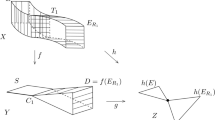Abstract
The aim of this paper is to construct families of Calabi-Yau threefolds without boundary points with maximal unipotent monodromy and to describe the variation of their Hodge structures. In particular five families are constructed. In all these cases the variation of the Hodge structures of the Calabi-Yau threefolds is basically the variation of the Hodge structures of a family of curves. This allows us to write explicitly the Picard-Fuchs equation for the one-dimensional families. These Calabi-Yau threefolds are desingularizations of quotients of the product of a (fixed) elliptic curve and a K3 surface admitting an automorphisms of order 4 (with some particular properties). We show that these K3 surfaces admit an isotrivial elliptic fibration.
Similar content being viewed by others
References
Artebani M.: A one dimensional family of K3 surfaces with a \({\mathbb{Z}/4\mathbb{Z}}\) action. Can. Math. Bull. 52, 493–510 (2009)
Borcea C.: K3 surfaces with involution and mirror pairs of Calabi-Yau manifolds, in: mirror symmetry, II. AMS/IP Stud. Adv. Math. 1, 717–743 (1997)
Cynk S., Hulek K.: Higher dimensional modular Calabi-Yau manifolds. Can. Math. Bull. 50, 486–503 (2007)
Dolgachev, I.V., Kondo, S.: Moduli of K3 surfaces and complex ball quotients. In: progress in mathematics. Arithmetic and Geometry Around Hypergeometric Functions, vol. 260, pp. 43–100. Birkhäuser, Basel (2007)
Garbagnati A., van Geemen B.: The Picard-Fuchs equation of a family of Calabi-Yau threefolds without maximal unipotent monodromy. Int. Math. Res. Notices 16, 3134–3143 (2010)
van Geemen, B.: Projective models of Picard modular varieties. In: Classification of Irregular Varieties, vol. 1515, pp. 68–99. Springer LNM, York (1992)
Miranda, R.: The basic theory of elliptic surfaces, Università à di Pisa, Dottorato di ricerca in matematica, ETS Editrice Pisa (1988)
Nikulin V.V.: Finite groups of automorphisms of Kählerian K3 surfaces (Russian). Trudy Moskov. Mat. Obshch. 38, 75–137 (1979)
Nikulin V.V.: Finite groups of automorphisms of Kählerian K3 surfaces. Trans. Moscow Math.Soc. 38, 71–135 (1980)
Nikulin V.V.: Factor groups of groups of the automorphisms of hyperbolic forms with respect to subgroups generated by 2-reflections. J. Sov. Math. 22, 1401–1475 (1983)
Rohde, J.C.: Cyclic Coverings, Calabi-Yau Manifolds and Complex Multiplication. LNM 1975. Springer, Berlin (2009)
Rohde J.C.: Maximal automorphisms of Calabi-Yau manifolds versus maximally unipotent monodromy. Manuscr. Math. 131, 459–474 (2010)
Shioda, T., Inose, H.: On Singular K3 surfaces. In: Complex Analysis and Algebraic Geometry, pp. 119–136. Iwanami Shoten, Tokyo (1977)
Voisin, C.: Miroirs et involutions sur les surfaces K3. Journées de Géométrie Algébrique d’Orsay (Orsay, 1992). Astérisque 218, 273–323 (1993)
Voisin, C.: Théorie de Hodge et Géométrie Algébrique Complexe, Cours Spécial 10. Société Mathematique de France, Paris (2002)
Author information
Authors and Affiliations
Corresponding author
Rights and permissions
About this article
Cite this article
Garbagnati, A. New families of Calabi-Yau threefolds without maximal unipotent monodromy. manuscripta math. 140, 273–294 (2013). https://doi.org/10.1007/s00229-012-0561-2
Received:
Revised:
Published:
Issue Date:
DOI: https://doi.org/10.1007/s00229-012-0561-2



